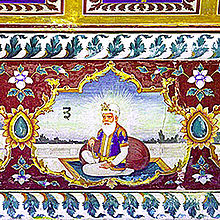Guru Amardas
| Guru Amar Das | |
|---|---|

Guru Amar Das - Goindwal
|
|
| Religion | Sikhism |
| Known for |
|
| Other names | The Third Master |
| Personal | |
| Born |
5 May 1479 Basarke village, (Present day Amritsar, Punjab, India) |
| Died | 1 September 1574 (aged 95) Goindval, Punjab |
| Spouse | Mata Mansa Devi |
| Children | Bhai Mohan, Bhai Mohri, Bibi Dani, and Bibi Bhani |
| Parents | Tej Bhan & Mata Lachmi |
| Religious career | |
| Predecessor | Guru Angad |
| Successor | Guru Ram Das |
Guru Amar Das ([ɡʊru əməɾ dɑs]; 5 May 1479 – 1 September 1574) was the third of the Ten Gurus of Sikhism and became Sikh Guru on 26 March 1552 at age 73.
Amar Das adhered to the Vaishnavism tradition of Hinduism for much of his life. One day he heard his nephew's wife, Bibi Amro, reciting a hymn by Guru Nanak, and was deeply moved by it. He persuaded her to introduce him to her father, Guru Angad, and in 1539, the year Guru Nanak died, Amar Das at the age of sixty met and devoted himself to Guru Angad and became a Sikh. In 1552, after the death of Guru Angad, he became Guru Amar Das, the third Guru of Sikhism.
Guru Amar Das was an important innovator in Sikhism, who introduced a religious organization called the Manji system by appointing trained clergy, a system that expanded and survives into the contemporary era. He wrote and compiled hymns into a Pothi (book) that ultimately helped create the Adi Granth. Guru Amar Das helped establish the Sikh rituals relating to baby naming, wedding (Anand Karaj), and funeral, as well as the practice of congregation and celebrations of festivals such as Diwali, Maghi and Vaisakhi. He founded centres of Sikh pilgrimage, and picked the site for the Golden Temple.
Guru Amar Das remained the leader of the Sikhs till age 95, and named his son-in-law Bhai Jetha later remembered by the name Guru Ram Das as his successor.
Amar Das was born to mother Bakht Kaur (also known as Lakshmi or Rup Kaur) and father Tej Bhan Bhalla on May 5, 1479 in Basarke village in what is now called Amritsar district of Punjab (India). He married Mansa Devi and they had four children which they named as Mohri, Mohan, Dani and Bhani.
Amar Das was a religious Hindu (Vaishnava, Vishnu focussed), reputed to have gone on some twenty pilgrimages into the Himalayas, to Haridwar on river Ganges. About 1539, on one such Hindu pilgrimage, he met a Hindu monk (sadhu) who asked him why he did not have a guru (teacher, spiritual counsellor) and Amar Das decided to get one. On his return, he heard Bibi Amro, the daughter of the Sikh Guru Angad, singing a hymn by Guru Nanak. He learnt from her about Guru Angad, and with her help met the second Guru of Sikhism and adopted him as his spiritual Guru who was much younger than his own age.
...
Wikipedia
